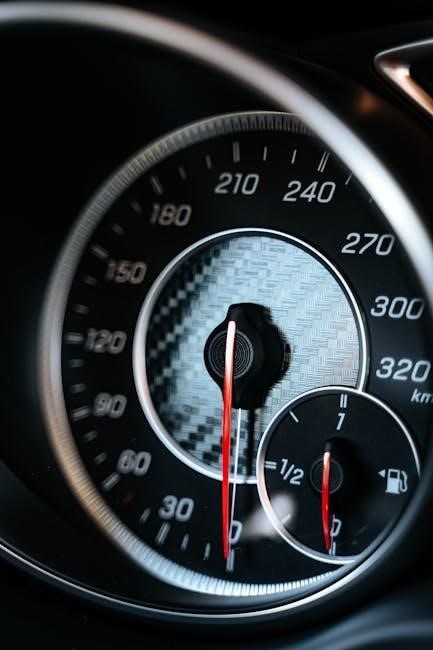The Nighthawk Carbon Monoxide Detector is a state-of-the-art device designed to detect CO buildup in residential areas. This manual will guide you on installation, testing, and maintenance for optimal functionality and safety. Ensuring your family’s protection from the silent killer.
1.1 Importance of Carbon Monoxide Detectors
Carbon monoxide (CO) is a odorless, colorless, and tasteless gas that can be deadly in high concentrations. CO detectors are crucial for early detection of this silent killer, providing life-saving alerts before symptoms arise. Prolonged exposure to CO can cause severe health issues, including headaches, dizziness, and even death. Detectors like the Nighthawk are essential for protecting families, especially in homes with fuel-burning appliances or attached garages. They act as an early warning system, giving occupants time to evacuate and seek fresh air. CO detectors are not just a safety precaution but a legal requirement in many regions. Installing a reliable detector ensures peace of mind and compliance with safety standards. Regular maintenance and testing of these devices are vital to ensure they function correctly when needed most.
1.2 Brief Overview of the Nighthawk Detector
The Nighthawk Carbon Monoxide Detector is a state-of-the-art safety device designed to protect families from the dangers of carbon monoxide. It continuously monitors the air for CO levels and provides clear alerts when dangerous concentrations are detected. The detector features a digital display that shows real-time CO levels, as well as a peak level memory function to track the highest CO concentration recorded. With both plug-in and battery-operated models available, the Nighthawk offers flexible installation options to suit various home setups. Its sleek design and user-friendly interface make it easy to integrate into any home safety system. Additional features include a test/reset button for quick functionality checks and a 10-year end-of-life warning to remind users when to replace the unit. The Nighthawk is a reliable and essential tool for ensuring home safety and peace of mind. Always refer to the user guide for proper installation and maintenance.

Features and Benefits of the Nighthawk Detector
The Nighthawk detector offers a digital display for real-time CO monitoring, peak level memory to track highest CO levels, and a test/reset button for quick functionality checks. Its plug-in and battery-operated options provide flexible installation, while the 10-year end-of-life warning ensures timely replacement. These features ensure continuous protection and accurate detection of carbon monoxide, offering peace of mind for homeowners.
2.1 Unique Features of the Nighthawk
The Nighthawk detector stands out with its peak level memory, which records the highest CO levels detected, aiding in monitoring and safety assessments. The digital display provides clear, real-time readings, while the test/reset button allows users to verify functionality and silence alarms. It also features a 10-year sensor life and an end-of-life warning, ensuring reliability over time. Additionally, the detector is compact and lightweight, making installation straightforward. These features collectively enhance user experience and ensure continuous protection against carbon monoxide threats. The Nighthawk’s design emphasizes ease of use and accuracy, making it a trusted choice for home safety.
2.2 Benefits of Using the Nighthawk Detector
Using the Nighthawk detector offers numerous advantages for home safety. Its digital display provides real-time carbon monoxide levels, enabling quick decision-making. The peak level memory feature records the highest CO concentration detected, which is invaluable for identifying potential risks. The detector’s compact design allows for easy installation in various locations, ensuring comprehensive coverage. Additionally, the 10-year sensor life reduces maintenance needs, while the end-of-life warning reminds users when replacement is necessary. The detector also offers dual functionality, detecting both carbon monoxide and explosive gases, providing enhanced protection. These features ensure reliable and continuous monitoring, giving users peace of mind and safeguarding their families from hidden dangers.

Installation Guide for the Nighthawk Detector
Proper installation is crucial for the Nighthawk detector to function effectively. Install it on walls or ceilings, at least 5 feet from fuel-burning appliances, and follow the user guide for accurate detection and optimal safety.
3.1 Where to Install the Detector
For optimal detection, install the Nighthawk detector in areas where carbon monoxide buildup is most likely. Place it near sleeping areas, at least 5 feet away from fuel-burning appliances like furnaces or water heaters. Avoid installing it in basements or furnace rooms. Ensure it’s at least 5 feet from any doors or windows to prevent drafts from interfering with sensor accuracy. Do not install it directly above or beside fuel-burning appliances. Instead, position it on walls or ceilings, ensuring a clear path for CO to reach the sensor. Follow these guidelines to maximize the detector’s effectiveness in safeguarding your home and family from carbon monoxide threats.
3.2 How to Install the Detector
Installing the Nighthawk Carbon Monoxide Detector is straightforward and ensures reliable performance. Begin by selecting a suitable location based on the manufacturer’s guidelines. For wall mounting, use the provided bracket and screws to secure the detector firmly. If using a ceiling mount, ensure it is at least 12 inches away from any wall. Plug-in models should be inserted directly into a standard electrical outlet, while battery-operated units require installing the batteries correctly. After placement, press the test button to verify proper function. Ensure no obstructions block the sensor and keep the detector away from direct drafts; Follow the user guide for specific model instructions to complete the installation successfully and maintain your home’s safety.
3.3 What to Avoid During Installation
When installing the Nighthawk Carbon Monoxide Detector, there are several key considerations to ensure proper function and safety. Avoid placing the detector near vents, windows, or doors, as drafts can interfere with accurate CO detection. Do not install the detector in areas with high humidity, extreme temperatures, or direct exposure to sunlight, as this may damage the sensor. Keep the detector away from combustion appliances, such as furnaces or water heaters, to prevent false alarms. Additionally, avoid covering the detector with curtains, furniture, or other obstructions that could block airflow. Never tamper with the internal components or disable the alarm features, as this could compromise its effectiveness. By following these guidelines, you can ensure your Nighthawk CO detector operates reliably and provides essential protection for your home and family.

Understanding Your Nighthawk Detector
The Nighthawk detector features a digital display, peak level button, and test/reset button. It has LED indicators for power and alarm status, ensuring clear and immediate notifications for CO detection.
4.1 Key Components of the Detector
The Nighthawk Carbon Monoxide Detector is equipped with essential components designed for accurate detection and user convenience. The digital display shows real-time CO levels, while the peak level button reveals the highest CO concentration detected since the last reset. The test/reset button allows users to test the alarm’s functionality and reset it after an alarm triggers. Two LEDs are included: a red light that illuminates during an alarm and a green light indicating normal operation. The detector also features a sensor designed to detect CO buildup accurately. Additional components include a battery lockout system to prevent tampering and a 10-year end-of-life warning to remind users when to replace the unit. These components work together to ensure reliable protection against carbon monoxide threats. Always consult the user guide for detailed information on each part’s operation and maintenance.
4.2 Understanding the Digital Display and Buttons
The Nighthawk Carbon Monoxide Detector features a digital display that shows the current CO levels in parts per million (PPM), updating every 30 seconds. This display helps users monitor air quality in real-time. The peak level button reveals the highest CO concentration detected since the last reset, providing valuable insight into potential threats. The test/reset button allows users to test the alarm’s functionality and reset it after an alarm sounded. The detector also includes two LEDs: a red light that illuminates during an alarm and a green light that indicates normal operation. Understanding these components ensures proper use and interpretation of the detector’s signals, enabling users to take appropriate actions to ensure safety; Always refer to the user guide for detailed instructions on operating these features effectively.

Testing and Maintaining the Detector
Regular testing and maintenance ensure optimal performance of your Nighthawk detector. Use the test/reset button to check functionality weekly. Clean the detector with a vacuum monthly and replace batteries annually or when the alarm chirps. Replace the detector after 10 years for continued safety.
5.1 How to Test the Detector
To ensure your Nighthawk Carbon Monoxide Detector is functioning properly, perform regular tests. Press and hold the test/reset button to activate the test mode. The alarm will sound briefly, confirming the detector is working. Additionally, use a carbon monoxide test kit for a more thorough check. Ensure the detector’s digital display updates every 30 seconds during testing. If the alarm chirps or flashes red, it indicates a potential issue. Always refer to the user guide for specific instructions, and test the detector weekly for reliability. This routine ensures early detection of CO buildup, providing critical time to respond. Remember, a functioning detector is essential for your family’s safety and peace of mind.
5.2 Maintenance Tips for Optimal Functionality
Regular maintenance ensures your Nighthawk Carbon Monoxide Detector operates effectively. Clean the detector monthly with a soft brush or vacuum to remove dust and debris. Check the expiration date on the unit, as detectors typically need replacement after 10 years. Replace batteries annually or as indicated by the low-battery chirp. Avoid exposing the detector to harsh chemicals or direct water, as this can damage the sensor. Test the detector weekly using the test/reset button to confirm proper function. If the alarm chirps or flashes red, refer to the troubleshooting section. Store spare batteries and user guides in an accessible location. By following these tips, you ensure reliable protection against carbon monoxide threats, safeguarding your home and family. Regular care extends the lifespan and performance of your Nighthawk detector.

Troubleshooting Common Issues
Common issues include false alarms due to low batteries or system malfunctions. Use the test/reset button to diagnose and resolve problems. Check for obstructions affecting sensor accuracy. Ensure your detector functions properly by addressing these issues promptly.
6.1 Common Issues and Solutions
Common issues with the Nighthawk Carbon Monoxide Detector include false alarms, low battery signals, and sensor malfunctions. False alarms can occur due to high humidity, cooking fumes, or nearby vehicle exhaust. To resolve this, ensure the detector is installed away from kitchens, garages, and bathrooms. For low battery signals, replace the batteries immediately and test the unit. If the detector chirps intermittently, check for obstructions blocking the sensor or clean the grille with a soft brush. End-of-life warnings indicate the detector needs replacement after 10 years of use. Resetting the detector using the test/reset button often resolves temporary glitches. Always refer to the user guide for specific troubleshooting steps to ensure your safety and the device’s reliability.
6.2 How to Reset the Detector
To reset the Nighthawk Carbon Monoxide Detector, press and hold the Test/Reset button until the alarm stops. This action will cancel any current alarms and reset the detector. If the detector is experiencing a low battery signal or a false alarm, resetting it will temporarily silence the alarm. For models with an End-of-Life Warning, resetting will not extend the detector’s lifespan but will provide a brief silence period before the warning resumes. Always ensure the detector is installed and maintained as described in the user guide to avoid unnecessary resets. Regular testing and maintenance are crucial for optimal performance and safety. If issues persist, consider replacing the detector or consulting the troubleshooting section for further assistance.
Frequently Asked Questions
Common questions include how to use the Test/Reset button, understanding the digital display, and proper installation locations. Additional FAQs address peak level memory and troubleshooting alarm sounds.
7.1 General Questions About the Detector
General questions often revolve around the purpose and functionality of the Nighthawk Carbon Monoxide Detector. Why is a CO detector important? Carbon monoxide is a odorless, colorless gas that can be deadly, making detection crucial for home safety. How does the Nighthawk detector work? It continuously monitors the air for CO levels and sounds an alarm if dangerous concentrations are detected. What features does it have? The detector includes a digital display, peak level memory, and a test/reset button for functionality checks. Where should it be installed? Ideally, place it near sleeping areas and on every level of your home. How long does it last? The detector has a 10-year sensor life, with an end-of-life warning to remind you to replace it. These questions help users understand the basics of the detector and its role in home safety.
7.2 Technical Questions and Solutions
Technical inquiries often focus on troubleshooting and resolving issues with the Nighthawk detector. Why does my detector chirp? Chirping may indicate low battery, a malfunction, or the need for replacement. How do I reset the alarm? Press and hold the Test/Reset button until the alarm stops. What does the digital display show? It displays CO levels in parts per million (ppm) and peak levels detected since the last reset. Can I link multiple detectors? Yes, certain models can interconnect to sound all alarms in the home; Why is my detector not working? Check for expired sensors, blocked vents, or loose connections. For persistent issues, contact Kidde’s Consumer Hotline at 1-800-880-6788. These solutions help users address technical challenges and ensure their detector operates effectively.
The Nighthawk Carbon Monoxide Detector is a vital safety tool designed to protect your family from the dangers of carbon monoxide. This guide has provided comprehensive information on installation, testing, maintenance, and troubleshooting to ensure optimal performance. By following the outlined steps and understanding the detector’s features, you can create a safer home environment. Always remember to test the device regularly and replace it as recommended. If you encounter any issues, refer to the troubleshooting section or contact Kidde’s Consumer Hotline for assistance. Your safety is a shared responsibility, and with the Nighthawk detector, you can trust in reliable protection against the silent killer. Stay informed, stay safe, and ensure your detector is always functioning correctly.


